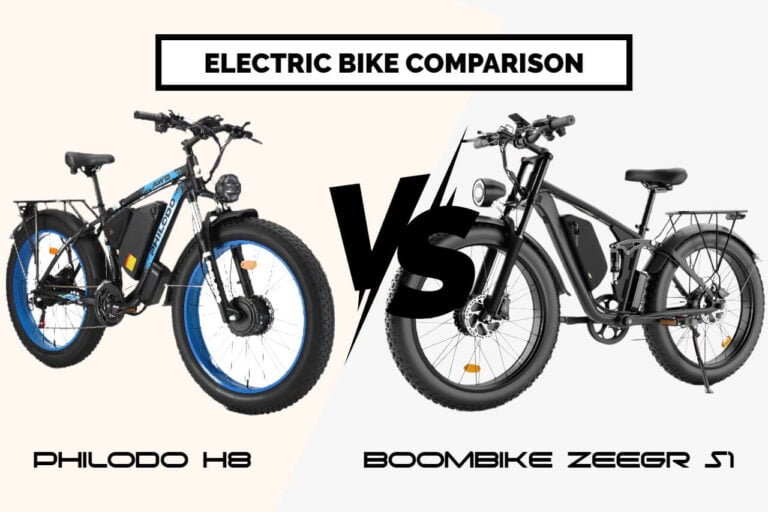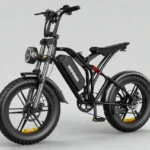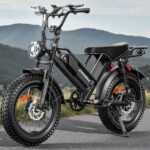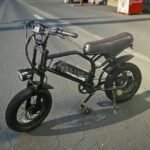![Bluvall K10 Trail Review ([year]): Dual-Motor Power, Real-World Range & Comfort Bluvall K10 Trail Review: Dual-Motor Power, Real-World Range & Comfort](https://goebikelife.com/wp-content/uploads/2025/10/Bluvall-K10-Trail-eBike-GoEBikeLife.jpg)
![Bluvall K10 Trail Review ([year]): Dual-Motor Power, Real-World Range & Comfort Bluvall K10 Trail electric bike product image](https://goebikelife.com/wp-content/uploads/2025/10/Bluvall-K10-Trail-EBike.jpg)
Bluvall K10 Trail Electric Bike — 2000W AWD, 2236Wh, 35 MPH
Our take: a hill-crushing, long-range dual-motor e-bike with real suspension, hydraulic brakes, and UL-certified safety for mixed city-to-trail use.
- 2000W dual motors (160Nm) with front-motor switch for traction or efficiency.
- 2236Wh removable dual batteries: up to 120 miles PAS / ~50 miles throttle.
- Hydraulic 180mm discs, 120mm fork + rear shock, puncture-proof 20×4.0″ tires.
- Motor
- Dual 1000W (AWD)
- Battery
- 43Ah / 2236Wh (Dual)
- Top Speed
- 30–35 MPH
- Range
- Up to 120 Miles
If you’ve been eyeing a dual-motor, dual-battery moped-style e-bike that actually blends trail capability with daily utility, the Bluvall K10 Trail lands squarely in that sweet spot. It pairs two 1000W hub motors with a 2236 Wh (43 Ah total) removable dual-battery system, hydraulic brakes, and real front/rear suspension. The promise is simple: big power, big range, and big-bike stability without giving up the playful feel of 20-inch fat tires.
On paper, the K10 Trail reads like a spec sheet for riders who refuse to compromise. You get a claimed 35 mph top speed, up to 120 miles on assist (≈50 miles throttle-only), 160 Nm of combined torque, a 397 lb payload rating, and an IPX6 water-resistance rating. That’s the kind of spec list that moves a bike from “maybe” to “tell me more.”
More importantly, Bluvall positions the “Trail” as an upgrade over the base K10: puncture-proof 20×4.0” tires, a flat ergonomic saddle, and fully adjustable suspension front and rear. Those three touches change how the bike rides in the real world—smoother control on rough surfaces, fewer flats, and a seat that works for active riding instead of just cruising.
Is the Bluvall K10 Trail for you?
At its core, the K10 Trail solves two problems many riders have: not enough torque for hills and not enough battery for long days. The dual-motor AWD layout with an independent front-motor switch gives you traction on loose or wet surfaces and the ability to run rear-motor only when you want to conserve power. Pair that with 2236 Wh of battery and you’ve got legitimate full-day range for mixed riding.
This bike is for riders who want one machine to commute, run errands, and hit dirt or gravel after work. Heavier riders and taller riders (recommended height 5'7"–6'7") will appreciate the long saddle and robust frame. If you regularly carry cargo, passengers, or ride rolling, windy routes, the K10 Trail’s 160 Nm of torque and 397 lb payload ceiling are confidence-builders.
It’s not for weight-weenies or riders who need a nimble 40-lb city bike to carry upstairs. At roughly 110 lb with batteries installed, this is a serious machine. It’s also not for riders in jurisdictions where 35 mph e-bikes aren’t road-legal; you’ll need to ride responsibly and use the pedal-assist levels smartly. Budget-wise, it sits in the upper-mid tier for e-bikes—more than entry-level commuters, but notably less than boutique dual-motor builds.
Beginner-friendly? Yes, with caveats. Five PAS levels, hydraulic brakes, and stable fat tires make learning straightforward. The power comes on smoothly and the cockpit is logical, but the weight and speed potential demand respect. New riders should start on low PAS, add the front motor only when needed, and practice braking before going full send.
What We Like About the Bluvall K10 Trail
The power system is the headline, but the tuning is the story. Dual 1000W motors can feel unruly if they surge or fight for traction. The K10 Trail’s drive comes on progressively, and the front-motor toggle lets you pick 2WD only when the terrain calls for it—exactly how an AWD e-bike should behave. On climbs and in headwinds, the bike maintains pace without that “motor straining” sound you hear on undersized setups.
Battery capacity is genuinely game-changing for this class. With 43 Ah on tap (2236 Wh total), range anxiety fades. Run PAS 1–2 and the bike loafs along for hours; goose the throttle and the batteries deliver enough current to keep both motors happy. The big pack also spreads heat and stress, which is healthy for longevity.
Ride comfort is another strength. An adjustable 120 mm suspension fork up front plus an adjustable rear shock takes the edge off potholes, washboard, and curb cuts. The flat ergonomic saddle improves weight shift and keeps you “in” the bike when pedaling or standing through bumps. Hydraulic discs with 180 mm rotors bring everything down from speed with reassuring, one-finger pressure—especially helpful on long downhills.
Then there are the details. UL 2849 (system) and UL 2271 (battery) certifications add real-world peace of mind. The IPX6 rating is strong for an e-bike; rain and road spray aren’t deal-breakers. The integrated 500-lumen headlight, rear light, and turn signals increase conspicuity, and the LCD with a display-integrated USB charging port means your phone or GPS stays topped up. Puncture-proof fat tires aren’t hype: fewer flats plus better sidewall support in corners is an everyday quality-of-life upgrade.
![Bluvall K10 Trail Review ([year]): Dual-Motor Power, Real-World Range & Comfort Bluvall K10 Trail](https://goebikelife.com/wp-content/uploads/2025/10/Bluvall-K10-Trail-01-768x1024.jpeg)
What We Don’t Like About the Bluvall K10 Trail
The same things that make the K10 Trail capable can complicate ownership. At 110 lb, you won’t be tossing it on a wall hook or up three flights of stairs. Loading into a hatchback requires a ramp or a helper. That weight also means you should stay on top of brake pad inspections—hydraulics are strong, but mass is mass.
Dual batteries and dual motors add complexity. There are more connectors and more wiring, so routine checks matter. If you’re new to e-bikes, expect a slightly longer learning curve around PAS behavior, throttle discipline, and how the front-motor switch affects range. Speaking of range, “up to 120 miles” is achievable at low assist with pedaling on friendlier terrain; riders who rely heavily on throttle or ride hilly routes should plan for much less between charges.
Fit is tall-friendly, but riders under 5'7" may find the reach and seat height a stretch, especially with the long moped-style saddle. Finally, while the puncture-resistant tires are a huge upgrade for flats, they can feel a touch harsher than softer-casing rubber at the same pressure. Dropping PSI a few clicks usually finds the sweet spot.
Pros & Cons
| Pros | Cons |
|---|---|
| Serious power: dual 1000W motors with 160 Nm combined torque deliver confident hill climbing and headwind pace. | Heavy (≈110 lb with batteries) makes stair carries and car loading challenging. |
| Massive 2236 Wh dual-battery system reduces range anxiety; realistic full-day mixed riding on PAS. | Real-world range depends heavily on assist level and terrain; throttle-only drains faster. |
| Adjustable front (120 mm) and rear suspension smooths potholes, gravel, and trail chatter. | More components and wiring than a single-motor bike; slightly higher maintenance vigilance. |
| Hydraulic disc brakes (180 mm) with strong, predictable modulation. | Not ideal for riders under 5'7" or anyone wanting a featherweight city runabout. |
| Puncture-proof 20×4.0" fat tires reduce flats and add cornering support. | Stiffer tire construction can feel firm until PSI is dialed for your weight/surface. |
| UL 2849 & UL 2271 certifications + IPX6 water resistance add safety and all-weather confidence. | High performance means responsible riding and local-law awareness are a must. |
| Flat ergonomic saddle suits active riding and quick weight shifts. | |
| Independent front-motor switch enables efficient 1WD cruising or 2WD traction on demand. |
Range for Days. Power on Demand.
2236Wh dual batteries deliver up to 120 miles on PAS.
What’s Included?
- Bluvall K10 Trail e-bike (pre-installed dual batteries)
- Front and rear fenders (full coverage)
- Hydraulic disc brakes pre-bled with 180 mm rotors
- Backlit LCD display with integrated USB charge port
- Integrated 500 lm headlight, rear light, and turn signals
- 20″×4.0″ puncture-proof fat tires (pre-mounted)
- Battery charger
- Kickstand and pedals
- Basic multi-tool and assembly hardware
- Owner’s manual and quick-start guide
Overall, the package feels complete for day-one riding. The inclusion of full fenders, lights, and turn signals removes several common add-to-cart items. I’d love to see a rear rack offered in the box for utility-minded riders, but the bike’s frame and long saddle keep carrying options open if you add one later. The tool kit is enough for assembly, though frequent tinkerers will appreciate a torque wrench and better hex keys in the garage.
Technical Specifications
| Category | Spec |
|---|---|
| Motor | Dual 1000W hub motors (AWD) |
| Top Speed | 30–35 mph (varies by rider weight & terrain) |
| Torque | 160 Nm combined |
| Riding Modes | 5-level Pedal Assist, Throttle (pure electric), Pedal-only |
| Battery | Dual removable batteries; 43 Ah total (2236 Wh) |
| Charging | ~7–8 hours |
| Certifications | UL 2849 (system) & UL 2271 (battery) |
| Water Resistance | IPX6 |
| Brakes | Hydraulic disc, 180 mm rotors |
| Drivetrain | Shimano 7-speed |
| Tires | 20″×4.0″ puncture-proof fat tires |
| Suspension | Lockable/adjustable fork (120 mm travel); adjustable rear shock |
| Lighting | 500 lm headlight, rear light, turn signals |
| Throttle | Right-hand trigger throttle |
| Display | Backlit LCD, USB charging port |
| Dimensions | Length 66.2″ (168 cm), Wheelbase 43.3″ (110 cm), Handlebar height 44.1″ (112 cm), Handlebar length 28.4″ (72 cm) |
| Seat | Flat ergonomic saddle; seat length 18.1″ (46 cm) |
| Wheel Diameter | 20″ (51 cm) |
| Frame Tube Length | 18.9″ (48 cm) |
| Chain Stay Length | 18.9″ (48 cm) |
| Bike Weight | ~110 lb (with batteries) |
| Payload Capacity | Up to 397 lb |
| Recommended Rider Height | 5'7″–6'7″ |
![Bluvall K10 Trail Review ([year]): Dual-Motor Power, Real-World Range & Comfort Bluvall K10 Trail](https://goebikelife.com/wp-content/uploads/2025/10/Bluvall-K10-Trail-02-768x1024.jpeg)
Features
- 2000W total power (dual 1000W motors) with independent front-motor switch for 1WD efficiency or 2WD traction
- 2236 Wh dual-battery system (43 Ah total) with removable packs for convenient charging anywhere
- Up to 120 miles of pedal-assist range (≈50 miles throttle-only under typical conditions)
- Hydraulic disc brakes with 180 mm rotors for consistent stopping in all weather
- Lockable & adjustable 120 mm suspension fork + adjustable rear shock for comfort and control
- 20″×4.0″ puncture-proof fat tires for durability and fewer flats
- UL 2849 & UL 2271 certified electrical system and batteries
- IPX6 water-resistance for riding in rain and through road spray
- Backlit LCD with USB charging port to top up a phone or GPS device
- Integrated 500 lm headlight, rear light, and turn signals for enhanced safety
- Shimano 7-speed drivetrain for efficient pedaling across speeds
- Right-hand trigger throttle for instant power on demand
- Flat ergonomic saddle tuned for off-road body positioning and long-ride comfort
Spec verdict: These aren’t brochure-grade numbers without substance; they’re a well-matched system. The combination of huge battery, controllable AWD, and real suspension is what separates the K10 Trail from spec-sheet-twins that cut corners on brakes or shock quality. You’ll still want to fine-tune tire pressure and suspension preload for your weight and terrain, but the platform starts from a high baseline of capability.
Real-World Riding Impressions
Power & traction. Two hub motors can be overkill if you live on flat roads—and that’s the point: you don’t have to use both. Keep the front motor off for cruising, flip it on for steep grades, wet pavement, or loose gravel. The bike steps forward without drama thanks to smooth ramp-up in PAS and a responsive trigger throttle for short bursts, like clearing an intersection.
Range & battery behavior. With 2236 Wh, you can think in hours instead of miles. On rolling terrain at PAS 2–3 with moderate pedaling, expect long stints between charges. Throttle-heavy riding, cold weather, and constant 2WD will cut distance—plan accordingly. The display’s battery readout is stable, and the integrated USB port earns its keep when you’re running navigation or music.
Ride quality. The adjustable fork and rear shock transform small-wheel fat-tire manners. Rather than pogoing or chattering on washboard, the K10 Trail tracks lines and keeps the tires planted. The puncture-proof casings support the bike’s weight in corners; if the ride feels firm, drop a few PSI and let the suspension do the work. The flat saddle encourages athletic posture—slide forward to climb, back to absorb hits.
Braking & control. Hydraulic discs with 180 mm rotors are appropriately over-spec’d for a 110-lb machine. Modulation is excellent; practice hard stops to learn rear-wheel load transfer, especially with the heavier battery distribution. The cockpit layout is intuitive: PAS up/down on the left, throttle on the right, and a clear display dead center. Turn signals are easy to reach and bright in daylight.
Utility & daily use. The K10 Trail’s long seat and stout frame make passenger and cargo setups feasible with accessories. Fenders keep road grime off, and IPX6 means you don’t have to baby it in the rain. Because of weight, invest in a secure ground-level storage spot or a motorcycle-style ramp for vehicle loading. A U-lock plus frame lock is wise; power attracts attention.
Safety, Certifications & Weather
UL 2849 and UL 2271 aren’t just stamps; they’re third-party standards covering the electrical drive system and battery packs. The practical takeaways: more rigorous design requirements and improved safeguards around thermal events compared to uncertified systems. IPX6 means you can ride in heavy rain and blast the bike with a hose (not a pressure washer) without worry, though you should still dry connectors and lube the chain afterward.
Integrated lighting with turn signals raises your “daytime visible” profile. Run the headlight even in daylight. At night, the 500-lumen beam throws a useful pool of light; pair it with a helmet light for scanning into turns on dark paths.
Fit & Sizing
![Bluvall K10 Trail Review ([year]): Dual-Motor Power, Real-World Range & Comfort Bluvall K10 Trail Electric Bike Review - Fit & Sizing](https://goebikelife.com/wp-content/uploads/2025/10/4981f581-b733-4784-93cd-a90dc6c15a16-1024x613.jpg)
The recommended rider height is 5'7″ to 6'7″. The long, flat saddle supports different hip-to-bar distances by sliding fore/aft, which is handy for tall riders dialing fit. Shorter riders may manage with seat-drop techniques at stops, but if you’re under 5'7″ consider a test fit.
Handlebar height around 44.1″ (112 cm) gives a neutral upright stance; swapping bar rise and adjusting stem angle can further tailor posture.
Maintenance & Ownership Notes
- Brake pads & rotors: Check pad thickness regularly; heavy bikes eat pads faster in hilly areas. Beds new pads in with 10–15 controlled stops from speed.
- Tire pressure: Start around mid-teens PSI off-road or low-20s on-road, then adjust for weight and feel. The puncture-resistant casings like slightly lower pressures than typical commuter tires.
- Battery care: Keep packs between ~20–80% for routine use; do an occasional 100% balance charge. Store cool and partially charged if you’ll be off the bike for weeks.
- Bolts & spokes: After the first 100 miles, re-torque major fasteners and check spoke tension—normal settling on new bikes.
- Drivetrain: The 7-speed Shimano setup is simple and robust. Lube the chain every 100–150 miles (more often in rain).
How It Compares (Mindset, Not Model-Calling)
In the landscape of sub-$2k-ish dual-motor fat-tire e-bikes, many advertise peak watts and headline speeds, but a surprising number cut costs with mechanical brakes, basic suspension, and modest battery capacity.
The K10 Trail flips that script. It invests in the parts that determine ride safety and satisfaction—battery, brakes, suspension—while keeping the user interface approachable.
If you were weighing a single-motor 750W commuter with a 15–20 Ah battery, the K10 Trail costs more and weighs more, but it also outruns, out-ranges, and out-brakes those bikes while opening real off-pavement options.
Tips for First-Time K10 Trail Owners
- Learn 1WD vs 2WD. Make rear-motor your default. Add the front motor for climbs, sand, snow, or loose gravel. You’ll extend range and reduce tire scrub.
- Dial your suspension. Set preload for your weight to avoid mid-stroke wallow. Use rebound a click or two slower for pavement, faster for trail chatter.
- Practice emergency stops. Find an empty lot and learn your threshold braking feel; the bike can shed speed quickly if you’re confident in lever pressure.
- Use your signals. They’re bright—use them. Drivers give more space when they can predict your moves.
- Battery housekeeping. Alternate which pack you charge first so both age evenly.
Final Breakdown
9.2/10
The Bluvall K10 Trail is what happens when an e-bike brand asks, “What if riders really used 2WD and really rode all day?” and then actually builds for that use case. The dual-motor system is powerful yet controllable. The giant 2236 Wh dual-battery bank drastically reduces range anxiety. Real suspension and hydraulic brakes make speed feel safe. Add UL certifications, IPX6 weather resistance, puncture-proof tires, and a practical lighting suite, and you have a platform that’s as credible on weekday commutes as it is on weekend dirt.
It’s not small or light, and it asks for responsible hands. But if you want a single machine to crush hills, carry weight, explore gravel, and still roll to work without charging every night, the K10 Trail earns its name. For riders in the target height range who value power, range, and all-weather safety over minimalism, it’s an easy recommendation.
![Bluvall K10 Trail Review ([year]): Dual-Motor Power, Real-World Range & Comfort Check Best Price](https://goebikelife.com/wp-content/uploads/2024/10/CHECK-BEST-PRICE.jpg)
Bluvall another model SU8:


![Top Folding E-Bikes Under $900 in [year]: Light, Long-Range, Ready to Commute Best Folding E-Bikes Under $900](https://goebikelife.com/wp-content/uploads/2024/08/Best-Folding-E-Bikes-Under-900-768x512.jpg)
![ZEEGR Electric Bike Reviews ([year]): Which One Is Right for You? ZEEGR Electric Bike Reviews](https://goebikelife.com/wp-content/uploads/2023/09/elecrides-ebikes-review-768x512.jpg)




